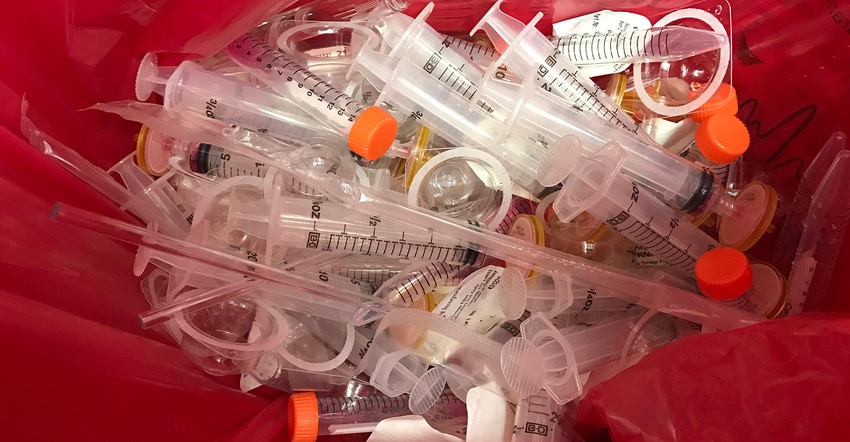Pyrolysis to Treat/Dispose Medical Waste: How Does it Fair Against Alternative Methods?
There’s a lot of industry chatter around pyrolysis. Is it an efficient and safe way to transform waste, and what types of waste for which industries? In this Q&A Dan Nienhauser, co-founder and CEO Stellar3, discusses pyrolysis’ role in managing medical waste—a fast-growing stream. U.S. hospitals produce almost six million tons of medical waste annually, calling for solutions.

There’s a lot of industry chatter around pyrolysis. Is it an efficient and safe way to transform waste, and what types of waste for which industries?
U.S. hospitals produce almost six million tons of medical waste annually, calling for solutions. In this Q&A Dan Nienhauser, co-founder and CEO Stellar3, discusses pyrolysis’ role in managing medical waste—a fast-growing stream.
Waste360: What happens to most medical waste from hospitals?
Nienhauser: Disposal of medical waste involves a complex set of definitions and processes based on waste type and local regulations.
In some large hospitals and medical facilities, medical waste is disposed of on-site. Other times, it is collected and treated off-site by specialized waste management companies. Sharps, pharmaceutical, and chemotherapy waste often have specific disposal methods.
Generally, mixed general waste from hospitals is disposed of separately from biologics and specialized wastes, in landfills and via general recycling programs, as outlined by both local regulations and services available from the waste collection company contracted by hospital(s).
In most countries, and even within regions, the handling and disposal of medical waste is heavily regulated. Improper disposal of medical waste can pose significant risks to public health and the environment, so healthcare providers and waste management companies take this process very seriously.
Waste360: What are alternatives to handling medical waste? Which ones work best?
Nienhauser: Historically, incineration has been a common method of treating medical waste, particularly hazardous and infectious waste. The process involves burning wastes at high temperatures to destroy them completely. There are several environmental concerns associated with incineration, including air emissions and ash disposal. In recent years, there has been a shift towards adopting more environmentally friendly alternatives due to concerns over air pollution and greenhouse gas emissions.
Medical waste is also treated by autoclaving, or steam sterilization. The waste is exposed to high-pressure steam, which kills pathogens effectively. Autoclaving is particularly useful for non-hazardous medical waste, such as non-infectious materials, plastics, and packaging. Often, autoclaved waste can be disposed of in municipal landfills.
Using microwave energy, various types of medical waste, including sharps, plastics, and liquids, can be treated. As an environmentally friendly alternative to incineration, it can often be integrated into waste management systems to improve their efficiency somewhat.
The Inertization Method is typically used for pharmaceutical waste. Before being disposed of in a landfill, the waste is mixed with cement and other substances to render it harmless.
A sanitary landfill is used to dispose of some medical waste after it has been treated to remove or neutralize hazardous components.
Proper disinfection of certain medical waste components, such as plastics and metals, can allow them to be recycled.
Waste360: What are advantages of pyrolysis for treating medical waste?
Nienhauser: It can reduce the volume of waste, eliminate pathogens, and destroy hazardous substances. Moreover, the process can generate energy in the form of heat or electricity, contributing to the overall sustainability of waste management practices.
Recently, with new engineering designs and commercial technology breakthroughs, pyrolysis has overcome challenges of capital and operational costs, and is able to work with mixed and higher variability medical waste, and efficiently process a variety of waste.
As a method of thermal decomposition in an oxygen-limited environment, Stellar3 chemical recycling (pyrolysis) is highly efficient at transforming various types of waste, including non-anatomical medical waste, into synthetic gases (Syngas) that can be used to generate electricity, condensed into green pyrolytic oils, or condensed into refined fuels (diesel or naphtha) for blends. By blending green pyrolytic oils with other petroleum products, new circular plastics or chemicals can be created.
Waste360: How does pyrolysis work? And what happens to the input?
Nienhauser: Thermal pyrolysis retorts from Stellar3 heat waste in an oxygen-depleted environment. Syngas is formed when waste contents decompose without oxygen. Syngas is then scrubbed for pollution control, cooled, and may be used as a fuel for electric generators. Based on the feedstock blend, up to 90% of the inputs are recycled, 8-12% are converted to gas, which is used to heat the pyrolysis retort, and 2-4% end up as ash that can be used to make bricks or disposed of.
Waste360: Are there emissions concerns around pyrolysis? How is it regulated?
Nienhauser: Stellar3 produces minimal emissions, which are compliant with the Waste Incineration Directive 2000/76/EC (air emissions are also in compliance with E.U. and California Clean Air Standards, as verified by third-party laboratories). If the local emission standards are more stringent than these, the plant will be designed to meet them. A plant's emissions are dependent on the feedstock mix, which is thoroughly tested and considered during the design phase and confirmed during pre-commissioning.
In the case of designs for a medical waste solution, the waste is transitioned after load into a hermetically sealed vessel with negative pressure to prevent emissions from escaping. The negative pressure will remove most particles from the shredder and dryer air streams, with the gas and particles then conveyed to the thermal oxidizer for destruction.
Waste360: What should we know about polyvinyl chloride medical waste? How does thermal decomposition handle these plastics?
Nienhauser: The use of polyvinyl chloride (PVC) plastics in medical settings is widespread, particularly for IV bags, tubing, blood bags, and catheters. Previously, there has been no current “circular solution” for PVC plastics. PVC can leach toxic additives into soil and groundwater in landfills. When burned in incinerators, it releases toxic chemicals into the air and creates highly toxic dioxin-laden ashes.
As a method of thermal decomposition in an oxygen-limited environment, Stellar3 chemical recycling (pyrolysis) is highly efficient in transforming mixed plastics, including PVCs, without requiring hazardous landfills or inefficient incineration to dispose of waste, as I described earlier through the pre-heating process followed by the process where medical waste is heated to up to 700°C in an oxygen-starved environment, with the contents in the feed decomposing into a gas which is scrubbed, fed through a Regenerative Thermal Oxidizer for pollution control, and cooled. There are minimal emissions from the plant.
Waste360: Tell us about your first facility and pilot
Our first facility is being constructed in the U.S. this year and will be used as a commercial validation site of mixed PVC plastics facility. A pilot bio-waste facility is currently being designed for operations beginning in 2024.
About the Author(s)
You May Also Like




